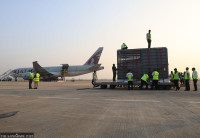Lumbini Province
Quarantine facilities in Province 5 crowded and mismanaged
Family members visiting quarantine facilities to bring food for their relatives increases the risk of rampant community transfer of the virus, say health officials.
Manoj Paudel
On May 14, it was announced that six officials from Kapilvastu’s Krishnanagar Municipality—including a non-gazetted first class official at the agriculture department, an office assistant and four security personnel—were infected with coronavirus.
While tracing their contacts, it was revealed that one of them, the first class official, had visited his brother, who was placed at the quarantine facility in Mahendra Secondary, almost every day to deliver food. Health officials say there's a high chance that he might have caught the virus during one of his visits.
Many locals in Kapilvastu these days visit quarantine centres to take food to their quarantined family members and relatives.
“The villagers do not adopt protective measures and bring the utensils used by the quarantined back home,” Hanuman Pandey, a local of Pakarbhitawa in Yashodhara Rural Municipality, said. “And in a close-knit village like ours, direct or indirect contact between individuals is unavoidable.”
In Pakarbhitawa, eight people have tested positive for the virus so far.
In Yashodhara Rural Municipality alone, there are 25 quarantine facilities that altogether house 1,139 individuals, most of whom are returnees from India. The rural municipality, however, provides food to half of them only, owing to the large number of quarantined individuals, according to Jyoti Prakash Dubey, chief of health bureau at the rural municipality.
“We are having difficulties managing food for the increasing number of quarantined individuals, hence we are asking the families of those infected, who live close by, to bring food for them,” Dubey said.
If Yashodhara is providing food to half of the quarantined individuals, Mayadevi Rural Municipality has stopped providing food at all.
“We provided food until Thursday, but now we can’t bear the cost, as the number of quarantined individuals keeps on rising,” Bajrangi Chaudhary, chief of Mayadevi, said. The local unit currently has 30 quarantine centres with 856 individuals in them.
Rajat Pratap Shah, mayor of Krishnanagar Municipality, echoes Chaudhary, saying that as the number keeps climbing, it’s hard for the local unit to bear the cost of food. Krishnanagar has quarantined 939 individuals so far.
However, the quarantine facilities get crowded in the morning and evening with family members bringing food, and this is very risky, said Sudarshan Thapa, a physician at the Butwal-based Corona-specific hospital. “If the management of the quarantine facilities is poor, then there’s a risk that the virus will run rampant through the whole community,” Thapa said. “The quarantine centres should be managed like hospitals.”
Local units and provincial officials in Province 5 have complained of a lack of coordination from the federal government to manage the quarantine centres.
Ram Bahadur Nepali, a public health officer at the provincial Infectious Disease Control Bureau, said that with many Nepalis still stuck at the borders, the risk of the virus’s outbreak has further intensified.
“Most of the infected in Province 5 are recent returnees from India,” Nepali said. “And many of those who are quarantined lack basic knowledge on how to prevent the contingent spread of the virus. The quarantine centres are crowded and utterly mismanaged.”
While the cases keep on rising, many local units do not have data on the number of possible returnees to pre-plan the setting up of quarantine facilities, which is another reason the facilities are crowded already, Nepali said.
According to the Rupandehi District Administration, about 1,000 individuals entered Nepal through the Sunauli border point this week, while nearly 900 are still stranded at the border. The number of those stranded at the border is increasing, but the district administration doesn’t have a record of the potential number of people trying to come to Nepal from India and overseas.
“We have asked each local unit to find out the number of people who are still abroad,” Mahadev Pantha, chief district officer of Rupandehi, said. “And those who are stranded at the border will be brought here with proper protective measures.”
As cases rise, the province is reeling under a lack of hospital beds and manpower and is scrambling to manage resources. As of Monday, the province has reported 159 cases of Covid-19, with Banke reporting the highest number with 81 cases. According to the Provincial Health Directive, as of Sunday, a total of 14,477 individuals are quarantined in 707 facilities across the province.
(Sanju Paudel and Ghanashyam Gautam contributed reporting from Rupandehi.)




 18.12°C Kathmandu
18.12°C Kathmandu












%20(1).jpg&w=300&height=200)

